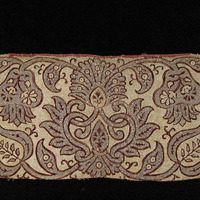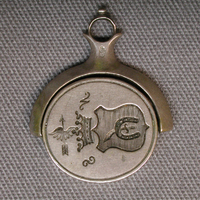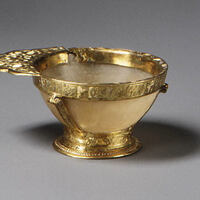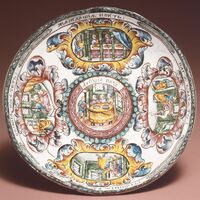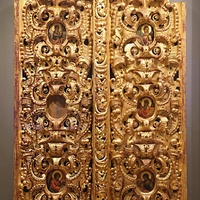Sofiya Alekseyevna
Images of Sofiya Alekseyevna Over Time
Sofiya Alekseyevna's birth did not mark her for anything more than the standard life of seclusion for Russian noble women, but the Tsar's death in 1682 allowed her to be one of the most powerful women in Russian history.1
Tsar Fyodor III’s death left Russia with a succession problem. The first in line for the crown was Fyodor’s brother, Ivan V. However, he was not mentally or physically well enough to be an effective ruler. After Ivan was Fyodor’s half-brother, nine-year-old Peter. 2 He was selected to be the next tsar, a decision which had devastating effects for his family. 3
Many of Peter’s family, the Naryshkins, were killed by the Streltsy, members of the Russian infantry who disagreed with the decision to deny Ivan tsardom. 4 In the chaos, Ivan V’s sister, Princess Sofiya Alekseyevna, began to play a role in restoring peace in Moscow. In the ensuing days, she spoke to the Streltsy and their demands became a joint rule between Peter and Ivan, rather than Ivan as the sole tsar. The young tsars’ regent would be Sofiya. 5
Sofiya issued various measures of propaganda in order to establish the legitimacy of her unconventional rule.6 Female members of the Russian royalty before Peter the Great’s push for westernization were expected to remain hidden from the public, within the walls of Moscow’s Terem, which meant that she would have to put lots of energy into making the Russian public comfortable with her power.7 She reinforced her validity with art, coins, participation in religious services, and giving herself importance through titles.8
Sofiya Alekseyevna’s rule came to an end with her being forced into seclusion within the Novodevichy Convent in 1704, as Peter the Great claimed more and more power for himself.9 Sofiya’s supporters viewed her as a devout Russian leader, especially compared to Peter the Great’s policies of westernization. She would, however, come to be remembered more as ambitious and conniving.10
Sofiya Alekseyevna’s may have lacked a crown, but she did the work that any Tsar at the time would have – creating stability as a Tsar through establishing and maintaining the strength of the dual-regency.11
Ephemera
These objects are related to Russian royalty during Sofiya Alekseyevna's lifetime
Notes
- Lindsey Hughes, Sophia, Regent of Russia: 1657-1704 (New Haven, CT: Yale University Press, 1990), 23, 101, https://doi.org/10.2307/j.ctt1xp3s49.
- Lindsey Hughes, “Sophia, ‘Autocrat of All the Russias’: Titles, Ritual, and Eulogy in the Regency of Sophia Alekseevna (1682-89),” Canadian Slavonic Papers / Revue Canadienne Des Slavistes 28, no. 3 (1986): 267; Lindsey Hughes, “Sofiya Alekseyevna and the Moscow Rebellion of 1682,” n.d., 521. 24 (2017): 49.
- Lindsey Hughes, “Sofiya Alekseyevna and the Moscow Rebellion of 1682,” The Slavonic and East European Review 63, no. 4 (1985): 533–35; Hughes, “Sophia, ‘Autocrat of All the Russias,’” 267.
- Hughes, “Sofiya Alekseyevna and the Moscow Rebellion of 1682,” 1985, 533–35; Hughes, “Sophia, ‘Autocrat of All the Russias,’” 267.
- Hughes, “Sofiya Alekseyevna and the Moscow Rebellion of 1682,” 1985, 535–36.
- Hughes, “Sophia, ‘Autocrat of All the Russias,’” 267–83.
- Hughes, “Sofiya Alekseyevna and the Moscow Rebellion of 1682,” 1985, 521, 522, 535; Hughes, “Sophia, ‘Autocrat of All the Russias,’” 274, 278.
- Hughes, 285.
- Hughes, 286.
- Hughes, 282; Hughes, “Sofiya Alekseyevna and the Moscow Rebellion of 1682,” 1985, 536.
